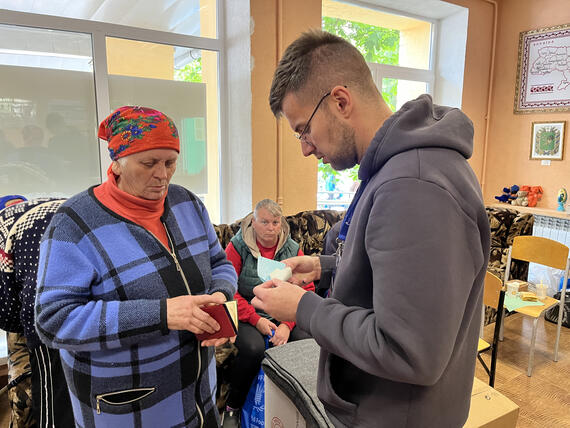Ukraine's Kharkiv transit centre: Finding comfort after fleeing home
By Viktoriia Andriievska and Tanya Lyubimova
In just three weeks, more than 12,000 people registered at a transit centre in Kharkiv City after fleeing their homes due to intense attacks in front-line communities. Evacuees and aid workers at the centre share their stories.
Valentyna: Leaving everything behind
Valentyna, 65, arrived at the transit centre from Okhrymivka village, located just 4 kms from the border. She and her daughter fled in a car arranged by a family friend.
"Those were terrible days when we had to hide in the basement of our house because of the constant bombardments," she recalled. "We left in a rush with only a small bag of things. Now we have to get everything, from toothbrushes to clothes."
Fighting back tears, Valentyna spoke about what they had to leave behind.

"We had a house and a well-maintained garden where we grew our own vegetables. That helped us to get by. Leaving this all behind, knowing my friends and extended family are still there, is truly the hardest thing," she said.
Their friend found them a modest apartment in Kharkiv City. At the transit centre, Valentyna registered for cash assistance and received aid including bedding and basic household items.
Humanitarian response in Kharkiv City
Since 10 May, nearly 50 humanitarian organizations have collaborated to support evacuations and provide assistance at the transit centre and temporary accommodation sites.
After months of hostilities, many people, particularly older people and those with disabilities, have depleted almost all their resources.
“People were evacuated, with the support of aid organizations, and some arrived using their own means,” explained Iryna, an aid worker from the Relief Coordination Centre. She joined the team last year after her husband, a volunteer in the Kharkiv Region, was killed during evacuations in the Kupiansk district.
“At the transit centre, people receive food, water, clothes, mattresses, bedding, household items, hygiene and other things they need,” she added.
Humanitarian partners also provide access to psychosocial support and legal assistance, including housing, land and property as compensation for damaged and destroyed property. Organizations conduct on-site referrals and case management when needed.
Yaroslav, from the non-governmental organization (NGO) FHI360, said: “Many people who come here are older people. Some people have been displaced more than once. They are under a lot of stress; some are severely traumatized or have panic attacks.”
Psychologists are available at the centre from morning until night to provide support.
Humanitarian partners also help out at Kharkiv’s railway station, referring people who fled by their own means and may need support.
Multipurpose cash assistance
Cash is one of the most requested types of assistance at the transit centre.
Anatolii, an aid worker from the NGO Right to Protection, explained: “In a humanitarian context like in Ukraine, cash is usually the preferred option because people fleeing homes have different needs. This cash means they can buy the things they most need. For some people it may be clothes or food; for others, medicines.”
The nearly 5,000 people who registered for cash assistance between 10 and 30 May typically received the money within a week.
The humanitarian multipurpose cash assistance programme in Ukraine is one of the world’s largest, involving almost 50 humanitarian organizations. Since February 2022, partners have provided multipurpose cash support to more than 10 million people.
Feeling safe and protected in a temporary shelter
“Most of the people who evacuated have found shelter in the homes of their relatives and friends,” said Iryna. “Those who had nowhere to go have been housed in collective centres set up in dormitories and other available premises fit to serve as temporary accommodation.”
Since mid-May, nearly 1,000 people, including more than 70 children and 140 people with limited mobility, have been accommodated in 46 collective centres in and around Kharkiv City.
At these centres, people receive food packages, hot meals, water, hygiene and household supplies, cash assistance, medical care and mental health support. Aid workers monitor the sites and arrange the necessary assistance.
“All the hygiene supplies – everything we need – is in these boxes, clothes as well. Even some colourful hairpins!” said Tamara. She and her husband, Nikolay, secured a family room in a collective centre after their home in Slobozhanske was damaged by four attacks and left in ruins.
Vita, a Ukrainian Red Cross volunteer from Vovchansk, noted: “The needs are growing as more and more people arrive.” She fled with her family in the first days of the evacuations and now dedicates all her time to supporting others.
“I will continue as long as it’s needed. These are my people and they need help.”
